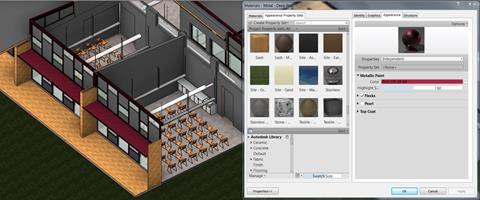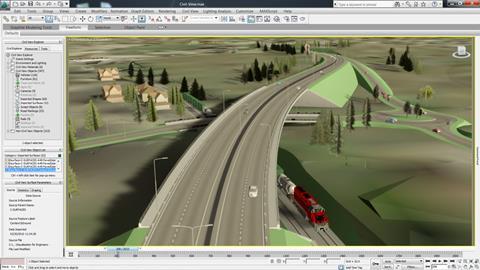The industry will have to put its foot down to meet the government’s BIM deadline. Here, five experts break the route in 10 key stages

The race is on. By 2016, all centrally procured government construction projects, no matter their size, must be delivered using ��ɫ����TV Information Modelling, or BIM. This will extend right through the supply chain, from the largest contractor to the smallest supplier, and it is hoped, will lead to the industry-wide adoption of BIM as the benefits become more widely understood. Across the industry, organisations must get up to speed over the next three years - or risk missing out on valuable opportunities.
A building information model contains not only the design of a building but data concerning the properties of its components, its construction and ongoing maintenance. The database and the way information is shared is as important as the model itself - which means that BIM doesn’t just mean a major technological change, but an overhaul of the whole design process. The transition from CAD to BIM will be much more significant than when computers replaced paper drawings, around 20 years ago. That merely automated the process, leaving it intact, while BIM is intended to transform how project teams work.
The government’s target is ambitious, but it does recognise that there are several stages along the way. The strategy paper produced by the Government Construction Client Group, reporting to the Department for Business, Innovation and Skills, uses the Bew-Richards maturity model, which defines three levels of BIM, based not only on the level of technology used to design a building, but on the level of collaboration within the process. Level 0 describes a paper-based process with CAD drawings; level 3 is a fully open and integrated process with models shared between the project team on a web-enabled BIM hub. That is still some way away, with a number of technological hurdles to be overcome first. For 2016, the target is level 2, in which separate disciplines create their own models, but all project data is shared electronically in a common environment.
Many firms have already begun implementing BIM, and some have been working on it for several years. We spoke to two architecture practices and two engineering firms that are well ahead of the game to find out what they’ve learned.
THE EXPERTS
Dave Glennon, project technology manager, and Mark Enzer, engineering director and BIM champion for Europe and Africa, Mott MacDonald
Mott MacDonald set a vision to be an early adopter of BIM two years ago. Since then, it has used BIM on a range of building and infrastructure projects.
Mark Stodgell, IT director, Pozzoni Architects
Pozzoni implemented BIM back in 2006. It now produces all projects to level 1 BIM and strives to meet level 2 wherever possible.
Lee Zebedee, formerly UK BIM manager, Ramboll
Engineer Ramboll started working in 3D in the late 1990s and was using collaborative BIM by 2006 on a healthcare PFI project. It is now used company-wide for clients in a wide range of sectors. In January 2013, Zebedee joined Autodesk.
Stephen Griffin, director, Allies and Morrison
Allies and Morrison started using BIM in 2009, and now works collaboratively with other designers on many of its projects.
1. GET OVER THE SOFTWARE
When companies see the cost of the software as a barrier to BIM, it’s a surefire sign that they don’t really understand what they’re taking on, says Stephen Griffin, director at Allies and Morrison. Your biggest investment is not going to be the BIM technologies themselves, he says, but the change management you will have to put into effect throughout your organisation. “BIM is about a process and that’s where the real cost will be. There’s really only one way of benefiting from the process and that’s to have a fully integrated internal and external team.”
Removing all possible technical barriers can encourage people to focus on the process instead, says Dave Glennon, project technology manager at Mott MacDonald. His team developed standard policies, procedures and processes, upgraded the behind-the-scenes infrastructure, and negotiated enterprise-wide licence agreements for key design products: “That makes the technology very available to people, but at a sensible cost because we can take advantage of economies of scale. If you resolve the basics, you make it easy for people to make the transition.”
There are other ways to take the sting out of the cost. A number of free products enable users to view and mark up models, which can be useful for members of the project team who are not actually designing, or to get an initial feel for the software.
These include Autodesk Design Review, Solibri Model Checker and Tekla BIMsight. Mark Stodgell, IT director at architect Pozzoni, notes that there is also a wealth of useful, independent information on the UK BIM Task Group website (), and a thriving social media community, which uses the #ukbimcrew hashtag on Twitter. “It’s 40 or 50 people in the UK who are engaged in what the government is trying to do and who are quite happy to share information,” he says.
2. WORK OUT WHERE YOU’RE STARTING FROM
A very important, but often overlooked, question is how exactly a firm is working in the first place. “BIM is about taking the tools and workflows that people are using and changing to a more transparent and collaborative way of working,” says Griffin. “You need to ascertain as much information about the technology and the process that you want to go towards, but first you need to understand the current situation in your office or practice.”
Over the last five years, he points out, every function of the practice has become increasingly reliant on technology. “It’s not just the programmes that the architects are using, but software for document control, HR and accounts, for example.”
3. DON’T LEAVE IT TO THE IT MANAGER
Everyone agrees that a chance as radical as BIM will only take hold with an organisation if it is led from the very top. At Mott MacDonald, the board set a vision for implementing BIM - something that engineering director Mark Enzer believes has been crucial. “Because the message is coming from the top, everyone listens - people think, ‘My career might depend on it, so I’d better get on board’. If the lead was coming from someone lower down the organisation, it wouldn’t be so successful.”
At Allies and Morrison, the partners who make the decisions are supported by a team of advisers who fully understand the technologies and can summarise them in a relevant way. “Decision makers don’t need that level of understanding of the technologies but they do need to have a thorough understanding of the processes that are being proposed,” says Griffin.


4. MAKE A PLAN
Once you have the leadership, you need a strategy to actually make their vision a reality. When Mott MacDonald began developing a strategy two years ago, a subcommittee of BIM enthusiasts was assembled from its offices around the world. “We decided to hold a global BIM summit,” says Enzer. “We brought people from around the world together, locked them in a room for the best part of a week, and ran through all of the technology and cultural issues we needed to address. For each one, we asked, ‘Is it important, is it a priority, and if so, what do we have to do about it?’”
Over the course of the week, and many flipcharts, a consensus gradually emerged. Then a smaller group convened to make sense of the workshop output and distil it into a concise strategy. At its biggest, the group numbered about 20, but Enzer says it was most productive when there were about 12.
One of the most important decisions, he believes, was to appoint BIM champions throughout the business, ranging from a senior director with global responsibility for leading BIM implementation across the group, through champions for each region - Enzer is BIM champion for Europe and Africa - and then each business unit, and local champions, implementing the strategy on the ground. “It’s a classic change-management technique,” he says. “When a lot of cultural change is involved, a huge amount depends on communication.”
5. LEARN ON YOUR OWN TIME
If you don’t tool up until your first live project, you’re not going to be popular with the rest of the team. Stodgell suspects that some firms hire BIM consultants to write very convincing statements to win tenders - which are not borne out once the work starts. “People are getting BIM consultants to fill out their prequalification questionnaires, but are only tooling up for BIM once they get the job. Then we find that our partners are taking their first step on the BIM journey on our time.”
Much better to crack on with a pilot project. “Select one with a reasonable timescale, or a friendly client who wants to explore BIM,” Stodgell advises, “or you’ll be struggling on your first live project.”
Lee Zebedee, formerly UK BIM manager at Ramboll, now customer success manager at Autodesk Consulting, says it’s important to choose a project that is representative of the work you do. “If you’re an architect and you normally design football stadiums, don’t choose a public toilet as your pilot project. It’s very easy to do - companies pick their simplest project as a pilot, then they don’t learn anything and it doesn’t push the software to find out if it’s right for them.”
Zebedee’s other tip is not to automatically choose your smartest people to lead the pilot. “If they’re not keen to adopt new technology, it won’t move forward. Enthusiasm is possibly the most important thing in staff who are adopting BIM. You can’t go too far wrong by picking enthusiasm.”
If you are trying out a new approach, do warn your client upfront. Stodgell notes that with BIM, drawings tend to emerge in one go at a later stage in the process, in contrast to the steady stream of CAD images clients might be expecting. “You’ve got to educate the client about what you’re doing, or they could think, ‘Where are the drawings? These guys are really slow …’”
6. MAKE IT EASY TO DO THE RIGHT THING
Perhaps the biggest leap is from a few BIM pilot projects to making the processes and technologies just part of business as usual. Company-wide standards are essential, says Zebedee, especially for the larger firms. “If you don’t have standards, people will be modelling in different ways, so it will be very hard to pass models from office to office and team to team.” For companies that are new to BIM, he recommends adopting an existing off-the-shelf protocol, such as the AEC (UK) BIM Protocols (aecuk.wordpress.com) or the protocols soon to be released by the UK BIM Task Group ().
At Mott MacDonald, Glennon worked alongside the quality management team to map existing processes to the new ways of working, and to modify the company’s integrated management system (IMS) - the set of processes and procedures used across the organisation. This enables security concerns to be addressed company-wide before they become a concern, and it means the IMS can assist implementation through communications and training.
“The key for us was embedding BIM into the integrated management system,” Glennon says. “So if you use the tools we provide and you do it in the way we set it up, you will be fulfilling the integrated management system. Most people want to do things in the right way, you just have to make it the easy way.” For example, one new element in the IMS are BIM execution plans. “It’s a key piece of work at the start of a project, when you sit down with the project team and set out how you’re going to work, and that’s the point of the IMS.”

7. DON’T TREAT EVERYONE THE SAME
BIM may be an organisation-wide change, but not everyone needs to be able to build a Revit model from scratch. “We mapped out the people in the organisation to try and understand their different needs,” says Glennon. “Practitioners using design tools will have different requirements from someone in business development, who needs to understand the concept and how to add value for the client but not how the tools work.”
Griffin identifies three types of person, based on a matrix of ability and willingness. There are the luddites, not willing or able to get to grips with the technology; the critical mass, who are generally willing but don’t have the skills; and the early adopters, mad keen and probably already using it.
“You need to educate the critical mass, support the early adopters and isolate the luddites. Other people say you should bring them along for the ride, I say isolate them and let them see for themselves if their old design processes are as efficient.”
8. DON’T TRAIN UNTIL THE LAST MINUTE
Early adopters of BIM have learned the hard way that training people to use the software before they need it can be a waste of money. “Experience tells us that the wrong way to do it is to buy a new product and train everyone straightaway, and then no one uses it for six months, by which time they’ve forgotten all their training,” says Zebedee.
Ramboll now trains on a just-in-time basis: “We identify a project, make sure the team is enthusiastic, and then train them so that they can support each other and jump straight on to the project.”
On key software products, Ramboll has also recruited in-house trainers to save money on external providers. “We go by the 80:20 rule. For the core software we use on 80% of projects, we have our own internal trainers, and then we buy in external training for the software required on the remaining 20%.”
It’s also important to have resources that people can access in a live situation, says Griffin. “The last thing you want is for an architect to come to something they weren’t taught or that they’ve forgotten and for them to be unable to issue a set of drawings.” Allies and Morrison can take advantage of an external support team who are available after UK business hours, via screen-sharing using GoToMeeting. Previous support calls are also categorised and logged so that they can be accessed later by others who may have the same issues.
9. DON’T USE EMAIL AS A PROJECT TOOL
It’s not just that email too often becomes a substitute for genuine communication - it simply isn’t up to the job. With BIM, company IT systems will have to cope with files that are many times larger than anything they’ve had to deal with in the past.
“Everyone thinks about whether their computer is fast enough, but they tend to forget about server capacity and the speed of your internet connection,” says Stodgell. “Files aren’t 1 or 2MB, they’re 20, 30, 40, 50 or even 200MB and you can easily run out of disk space.”
Swapping files and coordinating progress is much more straightforward with a dedicated project collaboration tool. Basecamp is cheap and simple; more sophisticated alternatives include Asite and 4Projects.
Glennon reckons associated project tools are just as important as the BIM platform itself. “It’s about making it easier for people to work in a more collaborative way - so you need associated technologies such as good networks, VoIP [voiceover internet protocol] and screen-sharing.”
10. STOP BUYING LOW-SPEC COMPUTERS
It may sound counter-intuitive, but by only buying top-spec, relatively expensive computers, you could actually save money. This is the approach Ramboll has taken. “We avoid ever buying low-spec PCs,” says Zebedee. “Whenever we have a new starter, we buy the highest-spec model that’s available within our budget at the time and filter all the machines down. Sometimes a machine will be swapped out three or four times. So the super-user gets a new machine, and their computer goes to an engineer who needs reasonable power, and their machine goes to a graduate or someone requiring less power, and the new starter or admin person gets their old machine.
“It’s a bit of a headache for IT, but it saves an absolute fortune because you can effectively upgrade four people for the price of one machine. And it means the super-users are always using the best computer possible.”
For listings of the latest construction project management software go here:
























7 Readers' comments